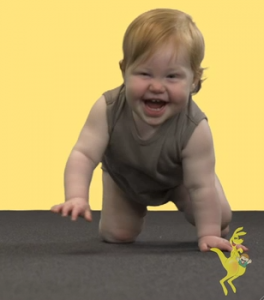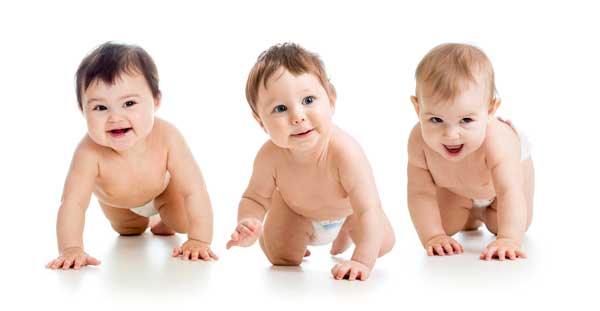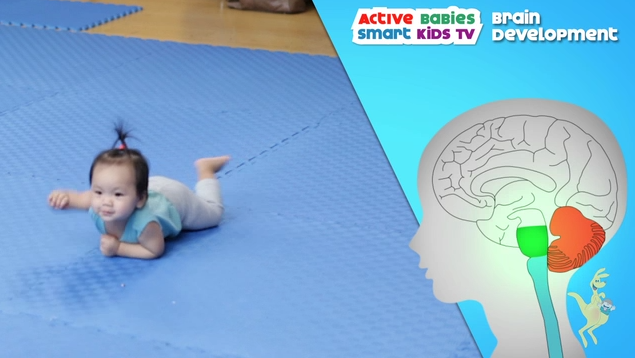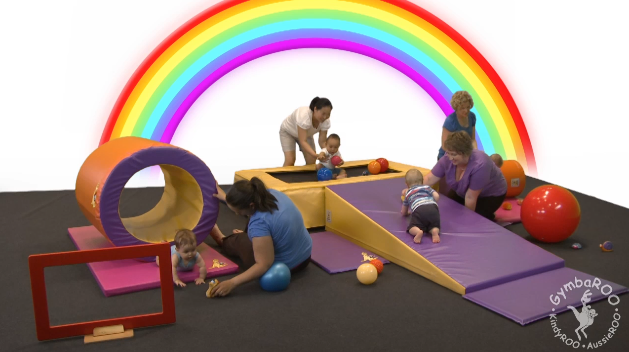Join the thousands of parents already raising smarter, happier babies with our online baby classes: The Active Babies Smart Kids series. Click here.
GymbaROO-KindyROO kids are excelling academically, emotionally, in leadership roles and on the sporting field. Find us at: GymbaROO-KindyROO
Dr Jane Williams and Bindy Cummings
It will greatly benefit your baby’s development if you know about the movements of crawling and creeping and how they help your baby’s brain and body development either before or during the months when your baby is crawling or creeping.
Crawling and creeping form an important part of the natural sequence of development, providing strong neurological foundations for many of the skills needed for later learning. By providing our babies with opportunities to move in this way we are giving them what they need to get the very best start to their lives.
As a matter of fact, the longer babies crawl and creep, the better it is for their future learning. There is no need to be in a hurry for your babies to walk – it is not how early a child walks, but how much is learned before walking that will influence the development of his/her physical, social and academic well-being.
It is not so important when both these movements start, but that they do. GymbaROO-KindyROO’s online Crawling and Creeping video includes expert advice and activities you can do with your baby, if he/she has missed these movement patterns. Access the video here
Crawling
Crawling begins once babies have developed the strength in their upper bodies to pull themselves forward – usually around 7 to 9 months, though this rate can vary considerably, depending on the child and the environment. When babies discover how to move forward in this way, they have reached a new level of brain development. This is the movement and neuro-developmental stage that preceeds the more mature creeping movement pattern that develops later in the first year.
Why tummy crawling is important
As babies tummy crawl across the floor, they are:
- Learning coordination of their bodies and limbs in preparation for creeping.
- Strengthening the arms and hands, legs and feet and finding out how to use them in preparation for climbing, walking, jumping and hopping.

- Developing the arches in their feet.
- Finding out that they have two sides to their bodies and how to balance them in movement.
- Stimulating hundreds of touch and positional messages that flow to their brains telling our babies about their limbs, tummies and where their bodies are in space.
- Developing visual skills as they see a toy in the distance and move towards it, making visual adjustments at varying distances.
- Learning about space and time – how far away is that toy and how long will it take me to get there?
- Integrating primitive reflexes, essential for future coordination and learning. Watch our free online video on primitive reflexes and the role they play in your babies development here.
Creeping
Once our babies lift their tummies off the floor and set forth on the voyage of discovery on hands and knees, they have reached the next level of brain development. At approximately the same time, they begin to sit themselves up, pull to standing and cruise around the furniture.
It is important to realise that babies will sit themselves up when they are developmentally ready. Being able to sit upright usually occurs after muscle strength in our babies legs, arms, shoulders and backs is well developed and their brains have matured to a point where important reflexes that aid in the healthy development of balance, posture, movement and stability are present. This usually occurs as they begin to creep – babies get up on hands and knees and then push themselves backwards to sit. Babies who are sat up prematurely generally have a slumped back and hold their legs wide to balance. Instead of making their muscles stronger, being ‘propped’ to sit actually has the opposite effect – it prevents the muscles needed for movement to be strengthened. Read: When should my baby be sitting.
Why creeping is important
- In the hands and knees position our babies are gaining tremendous muscle development, especially of the hands, so important for the development of fine motor skills such as writing and working with tools.
- Our babies are learning to coordinate the two sides of the body, with the hand on one side and the knee on the other hitting the floor at exactly the same time. Body rhythm and timing are important for thinking and moving required in later written work and mathematics at school.

- Vision is being fine-tuned. The distance between our babies’ eyes and the floor when creeping, is the same distance required between their eyes and their reading books at school age, for normal vision. Our babies are also learning to focus down at their knees then up at distant objects, making many visual adjustments from near to far and back again. This skill development is crucial for the ability to move visually and repeatedly between the front of the classroom and their school desk.
- Babies are learning many concepts, including; near/far, up/down, on/off, over/under, in/out. Many of these concepts are vitally important for future movement skills and understanding mathematics in later learning.
- Creeping helps to integrate more primitive reflexes, essential for future coordination and learning .
Mobile babies are much happier socially and emotionally. They are able to follow other people (or pets!) around, get the toy or object they seek, and keep themselves amused for much longer periods. Babies who cannot move forward can get bored very quickly and often demand that parents entertain them!
So many reasons to not be in a hurry for your babies to walk, but instead to give them every opportunity to gain the full brain and body development provided by the marvellous movements of crawling and creeping. Read: Baby milestones: A journey, not a race.
Dr Jane Williams (PhD, BMgt, RN(Paeds)) is the Research and Education General Manager for GymbaROO and KindyROO. Dr Williams is one of Australia’s leading experts on baby and child development. More on Dr Williams here.
Bindy Cummings (B.Ed(Human Movement) Hons) has worked as a teacher, child development consultant, early childhood development lecturer, teacher trainer and INPP & iLS consultant. She is the co-creator of GymbaROO’s Active Babies Smart Kids online series, has authored many published articles on child development. She is working on the content and development GymbaROO’s portal and online training programs, and the creation of new online programs for parents and children. More on Bindy Cummings here.
GymbaROO-KindyROO
Thousands of parents, babies and children are presently involved in our programs and creating rising stars. GymbaROO-KindyROO kids are excelling academically, emotionally, in leadership roles and on the sporting field. Come join all the fun and learning! “GymbaROO – The best decision I ever made for my child.” Classes from 6 weeks old – 7 years GymbaROO KindyROO
Active Babies Smart Kids – Online Baby Classes
GymbaROO-KindyROO’s online series of baby classes is taking the parenting world by storm! It is highly recommended by doctors, paediatricians, early childhood experts and the Maternal Child and Family Health Nurses Association. This series is being called: “The essential guide for parents”. Join the thousands of parents already playing with their babies from birth, in the best way for brain and body development and laying crucial foundations for future learning. What happens in the first year, not only matters, it matters a lot! Introductory video below.
Active Babies Smart Kids online series – Click here.
Try the first class FREE! Click here to watch our Active Babies Smart Kids Episode 1 – Tummy Time
Dr Jane Williams (PhD, BMgt, RN(Paeds)) is the Research and Education General Manager for GymbaROO and KindyROO. Dr Williams is one of Australia’s leading experts on baby and child development. More on Dr Williams here.
Enjoy the following GymbaROO-KindyROO articles
GymbaROO-KindyROO: Who, what, where, why and how
All about GymbaROO-KindyROO’s online baby classes for parents and babies: Active Babies Smart Kids
How to raise a smarter, happier baby
Why active babies make smart kids
Become a GymbaROO-KindyROO franchisee
Tummy time for baby’s healthy development.
What babies really want: Developmentally brilliant gifts for babies.
Bare feet for babies: Catching colds, trimming toenails and tips for first shoes.




